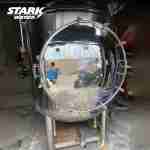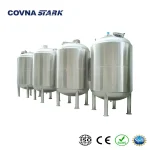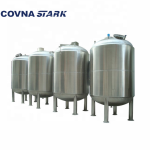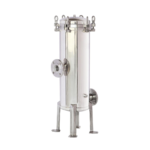Mastering the Mix: A Comprehensive B2B Guide to Stainless Steel Mixing Tanks
In countless industrial processes, from food and beverage production to chemical manufacturing and pharmaceuticals, the ability to achieve a consistent, homogenous mixture is fundamental to product quality, process efficiency, and operational success. At the heart of these critical operations often lies a robust and reliable piece of equipment: the stainless steel mixing tank. This guide is designed for plant managers, process engineers, procurement specialists, and distributors who need to understand, select, and utilize these vital assets effectively.
A Stainless Steel Mixing tank is far more than a simple vessel; it's an engineered system designed for the precise blending, dissolving, dispersing, emulsifying, or homogenizing of various substances. The choice of stainless steel as the construction material is deliberate, offering a unique combination of hygiene, durability, and corrosion resistance essential for demanding B2B applications. This article will explore the intricacies of mixing tank stainless steel designs, their benefits, key features, selection criteria, diverse applications, and maintenance considerations, providing you with the insights needed for optimal mixing performance.
What is a Stainless Steel Mixing Tank?
A Stainless Steel Mixing tank is a specialized industrial vessel constructed primarily from stainless steel alloys, equipped with an agitation system (such as an impeller, agitator, or mixer) designed to blend, stir, dissolve, suspend, or emulsify one or more substances within the tank. The primary goal is to achieve a desired level of homogeneity, facilitate chemical reactions, promote heat transfer, or maintain uniformity of a mixture.
These tanks are engineered to handle a wide range of viscosities, densities, and product characteristics. Key components typically include the tank shell, an agitator assembly (motor, gearbox, shaft, and impeller), baffles to enhance mixing efficiency, and various nozzles for inlets, outlets, instrumentation, and cleaning.
Why Stainless Steel is the Premier Choice for Mixing Tanks in B2B Applications
The selection of stainless steel for constructing mixing tanks in industrial and commercial settings is driven by several compelling advantages, making it superior to many alternative materials:
- Exceptional Corrosion Resistance: Stainless steel, particularly grades like 316L, offers excellent resistance to a wide array of chemicals, process fluids, and cleaning agents. This prevents product contamination from leached materials and ensures the tank's longevity.
- Hygienic and Sanitary Properties: The smooth, non-porous, and crevice-resistant surface of stainless steel (especially when properly finished) inhibits bacterial adhesion and biofilm formation. It's easy to clean and sanitize, making it the material of choice for industries with stringent hygiene standards like food, beverage, pharmaceuticals, and cosmetics.
- Durability and Structural Integrity: Stainless steel is a robust material that can withstand the mechanical stresses imposed by agitators, internal pressures, and temperature fluctuations. This ensures a long service life and operational reliability.
- Temperature Versatility: Stainless steel mixing tanks can effectively operate over a broad temperature range, accommodating processes that require heating, cooling, or involve exothermic/endothermic reactions. They can be jacketed or equipped with internal coils for efficient heat transfer.
- Chemical Compatibility: Various grades of stainless steel provide compatibility with a diverse range of products, from aqueous solutions to solvents and mildly acidic or alkaline substances.
- Product Purity: Stainless steel is non-reactive with most products, ensuring that it does not impart any taste, odor, or color to the mixture, nor does it contaminate the product with metallic ions.
- Ease of Fabrication and Customization: Stainless steel can be readily fabricated into complex tank designs with various features like dished bottoms, baffles, and specialized nozzle configurations to optimize mixing performance.
Key Features and Design Considerations for Stainless Steel Mixing Tanks
Effective mixing depends on the careful design and integration of several key features within the mixing tank stainless steel construction:
1. Tank Design and Geometry
- Shape: Cylindrical tanks are most common. Bottoms can be dished (ASME, torispherical), conical, or flat sloped to facilitate draining and cleaning.
- Capacity: Sized according to batch volume, process requirements, and residence time.
- Baffles: Vertical plates installed along the tank wall to break swirling patterns (vortexing) and promote axial flow, significantly improving mixing efficiency, especially with centrally mounted agitators.
2. Material Grades and Surface Finish
- Grade 304/304L Stainless Steel: Suitable for general-purpose mixing applications with non-corrosive or mildly corrosive products.
- Grade 316/316L Stainless Steel: Preferred for applications involving more corrosive substances, chlorides, or where enhanced hygiene and cleanability are critical (e.g., pharmaceutical, food-grade).
- Duplex Stainless Steels: Offer higher strength and superior corrosion resistance for very demanding applications.
- Surface Finish: Internal surfaces can range from standard mill finish (2B) to polished finishes (e.g., No. 4, #8 mirror finish) or electropolished for ultra-high purity and sanitary applications to minimize product adhesion and facilitate cleaning.
3. Agitation System – The Core of Mixing
The agitator is tailored to the specific mixing duty (e.g., blending, suspension, dispersion, emulsification, heat transfer).
- Types of Impellers/Agitators:
- Propellers: For low to medium viscosity fluids, good for blending and solid suspension.
- Pitched Blade Turbines (PBT): Create axial flow, effective for blending, solid suspension, and heat transfer.
- Radial Flow Turbines (e.g., Rushton): Create radial flow, good for gas dispersion and high-shear applications.
- Anchor Agitators/Paddle Agitators: For high viscosity fluids, promote mixing near the tank wall. Often used with scrapers.
- High Shear Mixers (Rotor-Stator): For emulsification, homogenization, and fine dispersions.
- Ribbon Blenders: For mixing powders or viscous pastes (though typically in horizontal trough mixers, principles apply).
- Motor and Gearbox: Sized based on the impeller type, fluid properties (viscosity, density), and desired mixing intensity.
- Shaft and Seal Assembly: The agitator shaft requires proper sealing to prevent leakage and contamination. Options include lip seals, packing glands, single mechanical seals, or double mechanical seals (often for aseptic or hazardous applications).
- Variable Speed Drive (VSD): Allows for adjustment of mixing speed to suit different process stages or product viscosities, offering greater process control and energy efficiency.
4. Heating and Cooling Features
Many mixing processes require temperature control.
- Jackets:
- Conventional Jackets: An outer shell around the tank for circulating heating or cooling media (steam, hot water, chilled water, glycol).
- Dimple Jackets: Offer good heat transfer efficiency and structural strength, often more cost-effective for larger tanks.
- Half-Pipe Coil Jackets: Provide excellent heat transfer and are robust for high-pressure media.
- Internal Coils: Helical or baffle-type coils inside the tank for direct heat exchange. Can be harder to clean in sanitary applications.
- Insulation: Applied to the tank exterior and jacket to minimize heat loss or gain and improve energy efficiency. Typically mineral wool or polyurethane foam with a protective outer cladding (e.g., stainless steel or aluminum).
5. Nozzles, Fittings, and Accessories
- Inlets/Outlets: For product addition, discharge, and recirculation. Sized and positioned for optimal flow.
- Drain Valves: Often flush-bottom type for complete drainage and minimal dead legs in sanitary designs.
- Vents/Breathers: To allow air displacement during filling/emptying and prevent vacuum/overpressure. Sanitary vents for aseptic processes.
- Manways: Top or side-mounted for access for inspection, cleaning, and maintenance. Hygienic manway designs are crucial for sanitary tanks.
- Sight Glasses & Lights: For visual monitoring of the mixing process.
- Sample Ports/Valves: For taking in-process samples.
- Instrumentation Ports: For mounting sensors (temperature probes, pressure transmitters, level sensors, pH/conductivity probes).
- Load Cells: For weighing the tank and its contents for accurate batching.
- CIP (Clean-in-Place) Systems: Spray balls or rotary jet heads integrated for automated cleaning.
Critical Factors for Selecting the Right Stainless Steel Mixing Tank
Choosing the appropriate Stainless Steel Mixing tank is a critical decision that impacts process efficiency, product quality, and operational costs. Consider these factors:
- Process Requirements: Define the mixing objective (blending, suspension, dispersion, emulsification, heat transfer, reaction). What is the desired outcome?
- Product Properties:
- Viscosity: Greatly influences agitator type and power requirements.
- Density: Affects power draw and suspension characteristics.
- Shear Sensitivity: Some products degrade under high shear.
- Corrosivity & Abrasiveness: Dictates material of construction and seal type.
- Solids Concentration & Particle Size (if applicable).
- Operating Conditions: Temperature, pressure (atmospheric or pressurized vessel), and vacuum requirements.
- Batch Size & Throughput: Determines tank capacity and agitator sizing for appropriate turnover rates.
- Sanitary/Hygienic Requirements: Crucial for food, beverage, pharmaceutical, and cosmetic industries (e.g., FDA, 3-A, EHEDG compliance, surface finish, cleanability).
- Heating/Cooling Needs: Required heat transfer area and type of jacket/coils.
- Space Constraints & Installation: Available footprint, height restrictions, and access for installation and maintenance.
- Automation & Control: Level of automation desired for mixing speed, temperature control, and batch sequencing.
- Budget and Total Cost of Ownership (TCO): Consider initial purchase price, installation, energy consumption, maintenance, and expected lifespan.
- Vendor Expertise and Support: Partner with a supplier experienced in designing and fabricating mixing tanks for your specific industry and application.
Diverse Industrial Applications of Stainless Steel Mixing Tanks
The versatility of mixing tank stainless steel designs makes them indispensable across a wide range of industries:
- Food & Beverage: Blending ingredients, dissolving sugars/salts, preparing sauces and dressings, dairy processing (milk, yogurt, ice cream mixes), beverage production (juices, soft drinks, syrups).
- Pharmaceuticals & Biotechnology: Preparing buffers and media, dissolving APIs, fermentation processes, vaccine production, blood plasma fractionation. Stringent sanitary design and validation are key.
- Cosmetics & Personal Care: Manufacturing lotions, creams, shampoos, gels, and ointments, often involving emulsification and precise temperature control.
- Chemical Processing: Blending reactants, catalysts, and solvents; facilitating chemical reactions; producing polymers, resins, adhesives, and specialty chemicals.
- Paints, Inks & Coatings: Dispersing pigments, blending resins and additives to achieve desired consistency and color.
- Water & Wastewater Treatment: Preparing and dosing chemical solutions (e.g., coagulants, flocculants, pH adjustment chemicals), sludge mixing.
- Agriculture: Mixing fertilizers, pesticides, and other agricultural chemicals.
- Biofuel Production: Mixing feedstocks, facilitating enzymatic reactions.
Maintenance and Care for Optimal Mixing Tank Performance
Proper maintenance ensures the longevity and efficiency of your stainless steel mixing tank:
- Regular Cleaning & Sanitization: Follow validated cleaning protocols (CIP/manual) appropriate for the product and industry. Inspect for residue after cleaning.
- Agitator System Inspection: Check motor, gearbox (oil levels, unusual noises), shaft alignment, and impeller integrity. Inspect seals for leaks and wear.
- Instrumentation Calibration: Regularly calibrate temperature, pressure, level, and other sensors for accuracy.
- Tank Integrity Checks: Inspect welds, nozzles, and tank shell for any signs of corrosion, pitting, or cracking, especially in demanding applications.
- Gasket and Seal Replacement: Replace worn manway gaskets, valve seals, and agitator seals as per manufacturer recommendations or when leaks are detected.
- Adherence to Operating Procedures: Ensure operators are trained and follow correct procedures for filling, mixing, emptying, and cleaning.
Conclusion: Investing in Precision, Purity, and Productivity
A well-designed and properly selected Stainless Steel Mixing tank is a cornerstone of efficient and high-quality industrial processing. Its inherent properties of hygiene, corrosion resistance, and durability, combined with tailored agitation and temperature control systems, make it an indispensable asset across numerous sectors. By understanding the key design features, operational parameters, and maintenance requirements, businesses can ensure their mixing tank stainless steel solutions deliver optimal performance, product integrity, and a strong return on investment for years to come.
Elevate your mixing processes with a solution built for excellence. Discover our range of high-performance Stainless Steel Mixing Tank systems or contact our process equipment specialists today to discuss your specific application and custom design needs.





